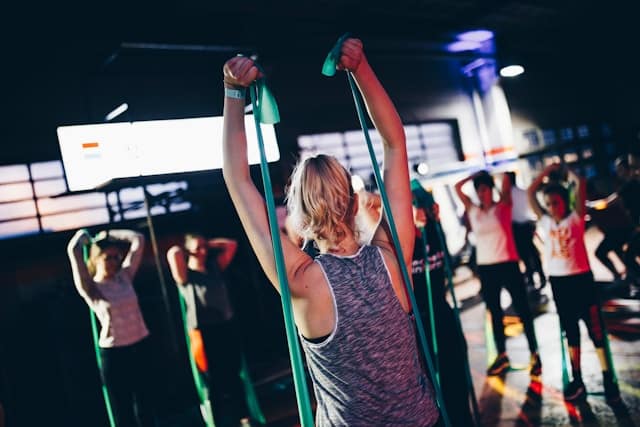In the world of speed skating, the difference between victory and defeat can often come down to a fraction of a second. Therefore, every moment on the ice matters, and every off-ice training session also holds significant importance. One crucial component of off-ice training for speed skaters is agility ladder drills.
Agility ladder drills help to enhance speed, balance, strength, and power, all of which are integral elements for a successful performance in speed skating. However, mere execution of these drills is not enough; they need to be optimized for maximum effectiveness. In this article, we will look at different ways to optimize agility ladder drills for speed skaters’ off-ice training, focusing on the significance of agility, strength, foot speed, core power, and balance in improving overall performance.
Dans le meme genre : What’s the Role of Dual-Task Training in Recovery from Concussion for Soccer Players?
Enhancing Agility through Ladder Drills
Agility is the athlete’s ability to move quickly and easily. In speed skating, agility plays a pivotal role as it facilitates rapid changes in body direction without losing balance, speed, or body control.
Agility ladder drills are an excellent tool for improving agility. They are designed to encourage fast foot movement, thus stimulating the nervous system to react quicker. This quick footwork translates to faster skating on the ice.
A lire également : How to Build a High-Performance Culture in a Newly Formed Cricket Team?
To optimize these drills, athletes should focus on executing each drill at a swift pace while maintaining proper form. Consistency is key; regular practice will yield significant improvements over time. Incorporating different variations of agility ladder drills, such as lateral movement drills and hopping drills, can also help to challenge and improve the athlete’s agility.
Building Strength and Power with Ladder Drills
Strength and power are foundational for any ice hockey player. They contribute to explosive starts, sustained speed on the ice, and are crucial to maintaining balance during tight turns or when resisting opponents.
While it may seem counterintuitive, agility ladder drills can indeed be used to build strength and power. By adding resistance to the drills, such as using weighted vests or resistance bands, athletes can increase the difficulty and intensity of the exercises. This added resistance will engage more muscles, therefore, building strength and power.
Another method to optimize these drills is through plyometric exercises. Adding jumps to ladder drills can significantly enhance power generation, which is essential for explosive starts in speed skating.
Improving Foot Speed and Quickness
Foot speed and quickness are vital attributes for speed skaters. The more rapidly a skater can move their feet, the quicker they can glide on the ice.
Agility ladder drills are an exceptional tool for improving foot speed. The quick, complex footwork required in these drills challenges the athlete’s coordination and speed. To optimize the drills for foot speed, it’s essential to focus on accuracy and speed. Athletes should strive to move through the ladder as quickly as possible while maintaining accurate foot placement.
Training in different directions, such as sideways, forwards, and backwards, can also help improve foot speed and agility in all directions, which is particularly beneficial for speed skaters.
Optimizing Core Power and Balance
The core is often referred to as the body’s powerhouse. A strong, stable core is necessary for balance, power, and control, all of which are vital for speed skating.
Interestingly, agility ladder drills can help to improve core strength and stability, leading to better balance on the ice. To optimize these drills for core power, athletes should focus on maintaining a strong, stable core during each drill. This can be achieved by consciously engaging the core muscles, particularly during more challenging drills.
Balance can also be improved by incorporating single-leg drills. These drills challenge the body’s stabilizing muscles, thereby improving overall balance.
Making the Most of Off-Ice Training Time
Ultimately, optimizing agility ladder drills for speed skaters involves making the most of the limited off-ice training time.
One way to achieve this is through high-intensity interval training (HIIT) sessions. By performing agility ladder drills in short, intense bursts, athletes can maximize their training efficiency, improving agility, speed, strength, and balance in less time.
Periodization, or systematically scheduling training intensity and volume, can also be highly beneficial. This approach allows athletes to focus on different aspects of their performance at different times, helping to prevent overtraining and optimize progress.
To conclude, agility ladder drills can play a key role in off-ice training for speed skaters. By focusing on agility, strength, foot speed, core power, and balance, and utilizing techniques such as resistance, plyometrics, HIIT, and periodization, athletes can optimize these drills for maximum effectiveness. As with any training regimen, consistency is key. With regular, optimized practice, speed skaters can expect to see significant improvements in their on-ice performance.
Program Design for Agility Ladder Drills
In the realm of hockey training, program design is a critical element. Having a well-structured plan can encourage consistent practice, ensure balanced development, and aid in preventing injury. For agility ladder drills, the program needs to be designed keeping in mind the key attributes a speed skater requires: agility, strength, foot speed, core power, and balance.
A well-designed program for agility ladder drills should incorporate a variety of exercises targeting each attribute. For instance, drills involving rapid change in direction stimulate agility, while those with resistance bands or weighted vests enhance strength power. Drills which focus on quick, intricate footwork will help to boost foot speed, and exercises requiring stabilization can improve core power and balance.
Introducing variation in the drills, such as moving sideways, forwards, and backwards, and incorporating single-leg drills, can further optimize the training program. Variation not only keeps the training engaging but also ensures a well-rounded development of skills.
Additionally, the program design should be progressive, gradually increasing in intensity and complexity. This will ensure that the hockey athletes are continually challenged, promoting continuous improvement. The program should also account for rest and recovery to prevent overtraining and injuries.
Season Training and High-Velocity Ladder Drills
The off-ice training of a hockey player should be in sync with the ice training and the competitive season. Season training involves adjusting the training intensity and volume in accordance with the season’s requirements. For instance, during the off-season, the focus can be on building strength and power, gradually shifting to enhancing speed and agility as the competitive season approaches.
High-velocity ladder drills can be highly effective in season training. These drills involve executing agility ladder exercises at top speed, thereby mimicking the high-speed conditions of a speed skating competition. When incorporated wisely into the season training plan, high-velocity ladder drills can help in maximizing the training impact.
For example, before the start of the competitive season, high-velocity ladder drills can be performed more frequently to boost the skater’s top speed and agility. This can help the athletes in acclimatizing to the high-speed conditions of the competitive events.
Conclusion
Agility ladder drills are powerful tools in the off-ice training regimen of speed skaters. They help in enhancing the attributes crucial for performance in speed skating, such as agility, strength, foot speed, core power, and balance.
However, to extract the maximum benefit from these drills, it’s essential to optimize them. This can be achieved through a well-designed program with varied and progressive exercises, incorporating high-intensity interval training (HIIT), plyometrics, and resistance training. Season training, including high-velocity drills, can also contribute significantly towards optimizing the efficacy of agility ladder drills.
The road to success in speed skating is paved with persistent training and diligent practice. By optimizing agility ladder drills, hockey players can hope to make the most of their off-ice training time, translating their hard work into on-ice victories. With consistent optimized practice, significant improvements in their performance can be expected. After all, in the world of speed skating, every fraction of a second counts, and every step on the agility ladder brings the athletes closer to their ultimate goal – speed.






